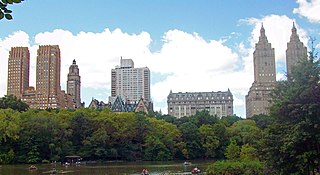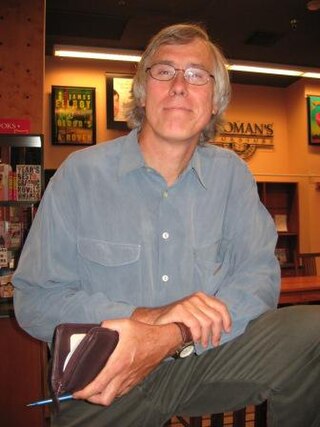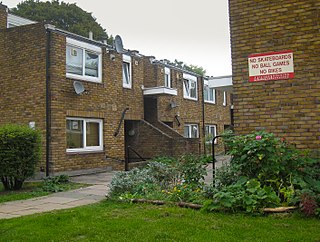Related Research Articles

An ecovillage is a traditional or intentional community with the goal of becoming more socially, culturally, economically, and/or ecologically sustainable. An ecovillage strives to produce the least possible negative impact on the natural environment through intentional physical design and resident behavior choices. It is consciously designed through locally owned, participatory processes to regenerate and restore its social and natural environments. Most range from a population of 50 to 250 individuals, although some are smaller, and traditional ecovillages are often much larger. Larger ecovillages often exist as networks of smaller sub-communities. Some ecovillages have grown through like-minded individuals, families, or other small groups—who are not members, at least at the outset—settling on the ecovillage's periphery and participating de facto in the community. There are currently more than 10,000 ecovillages around the world.

Cohousing is an intentional community of private homes clustered around shared space. The term originated in Denmark in late 1960s. Each attached or single family home has traditional amenities, including a private kitchen. Shared spaces typically feature a common house, which may include a large kitchen and dining area, laundry, and recreational spaces. Shared outdoor space may include parking, walkways, open space, and gardens. Neighbors also share resources like tools and lawnmowers.
A homeowner association, or a homeowner community, is a private association-like entity in the United States often formed either ipso jure in a building with multiple owner-occupancies, or by a real estate developer for the purpose of marketing, managing, and selling homes and lots in a residential subdivision. The developer will typically transfer control of the association to the homeowners after selling a predetermined number of lots.

A housing cooperative, or housing co-op, is a legal entity, usually a cooperative or a corporation, which owns real estate, consisting of one or more residential buildings; it is one type of housing tenure. Housing cooperatives are a distinctive form of home ownership that have many characteristics that differ from other residential arrangements such as single family home ownership, condominiums and renting.

A community garden is a piece of land gardened or cultivated by a group of people individually or collectively. Normally in community gardens, the land is divided into individual plots. Each individual gardener is responsible for their own plot and the yielding or the production of which belongs to the individual. In collective gardens the piece of land is not divided. A group of people cultivate it together and the harvest belongs to all participants. Around the world, community gardens exist in various forms, it can be located in the proximity of neighborhoods or on balconies and rooftops. Its size can vary greatly from one to another.
A planned unit development (PUD) is a type of flexible, non-Euclidean zoning device that redefines the land uses allowed within a stated land area. PUDs consist of unitary site plans that promote the creation of open spaces, mixed-use housing and land uses, environmental preservation and sustainability, and development flexibility. Areas rezoned as PUDs include building developments, designed groupings of both varied and compatible land uses—such as housing, recreation, commercial centers, and industrial parks—within one contained development or subdivision. Developed areas vary in size and by zoned uses, such as industrial, commercial, and residential. Other types of similar zoning devices include floating zones, overlay zones, special district zoning, performance-based codes, and transferable development rights.

A retirement community is a residential community or housing complex designed for older adults who are generally able to care for themselves; however, assistance from home care agencies is allowed in some communities, and activities and socialization opportunities are often provided. Some of the characteristics typically are: the community must be age-restricted or age-qualified, residents must be partially or fully retired, and the community offers shared services or amenities.

Sunward Cohousing is an intentional community located in Ann Arbor, Michigan, United States. Sunward's founders were pioneers in bringing the cohousing model to Michigan.
The defensible space theory of architect and city planner Oscar Newman encompasses ideas about crime prevention and neighborhood safety. Newman argues that architectural and environmental design plays a crucial part in increasing or reducing criminality. The theory developed in the early 1970s, and he wrote his first book on the topic, Defensible Space in 1972. The book contains a study from New York that pointed out that higher crime rate existed in high-rise housing projects than in low-rise complexes. This, he concluded, was because residents felt no control or personal responsibility for an area occupied by so many people. Throughout his study, Newman focused on explaining his ideas on social control, crime prevention, and public health in relation to community design.
The Miccosukee Land Cooperative (MLC) is a cohousing community. It is located near Tallahassee, in northeastern Leon County, Florida.
Exclusionary zoning is the use of zoning ordinances to exclude certain types of land uses from a given community, especially to regulate racial and economic diversity. In the United States, exclusionary zoning ordinances are standard in almost all communities. Exclusionary zoning was introduced in the early 1900s, typically to prevent racial and ethnic minorities from moving into middle- and upper-class neighborhoods. Municipalities use zoning to limit the supply of available housing units, such as by prohibiting multi-family residential dwellings or setting minimum lot size requirements. These ordinances raise costs, making it less likely that lower-income groups will move in. Development fees for variance, a building permit, a certificate of occupancy, a filing (legal) cost, special permits and planned-unit development applications for new housing also raise prices to levels inaccessible for lower income people.
Community Greens, sometimes referred to as backyard commons, urban commons, or pocket neighborhoods, are shared open green spaces on the inside of city blocks, created either when residents merge backyard space or reclaim underutilized urban land such as vacant lots and alleyways. These shared spaces are communally used and managed only by the residents whose homes abut them. They are not a public park, a private backyard, or a community garden; however, they can function as all three.
A pocket neighborhood is a type of planned community that consists of a grouping of smaller residences, often around a courtyard or common garden, designed to promote a close knit sense of community and neighborliness with an increased level of contact. Considerations involved in planning and zoning pocket neighborhoods include reducing or segregating parking and roadways, the use of shared communal areas that promote social activities, and homes with smaller square footage built in close proximity to one another. Features in the smaller homes are designed to maximize space and can use built in shelves and porch areas, encouraging time spent outside with a focal point around a greenspace.

Charles Durrett is an American architect and author based in Nevada City, California.

The Yarrow Ecovillage is an intentional community in Yarrow, British Columbia, Canada. Yarrow is a settlement of 3,000 population within the municipal boundaries of Chilliwack, British Columbia. The Ecovillage is a member-designed community that aims to achieve a more socially, ecologically and economically sustainable way of life. The Ecovillage's master plan for the 10-hectare (25-acre) former dairy farm, foresaw three main legal entities: An 8-hectare (20-acre) organic farm, a 31-unit multigenerational cohousing community, and a mixed-use development with just under 2800 m2 of commercial space, a 17-unit senior cohousing community and a learning centre.

Christie Walk is a model ecological cohousing development in central Adelaide, Australia. It consists of 27 dwellings on a 2,000 square metres site. It was designed by local architect Paul Downton and completed in 2006. Its innovative aspects include energy- and water-saving measures, use of ethical finance and use of recycled non-toxic materials.

A community orchard is a collection of fruit trees shared by communities and growing in publicly accessible areas such as public greenspaces, parks, schools, churchyards, allotments or, in the US, abandoned lots. Such orchards are a shared resource and not managed for personal or business profit. Income may be generated to sustain the orchard as a charity, community interest company, or other non-profit structure. What they have in common is that they are cared for by a community of people.

Cressingham Gardens is a council garden estate in Lambeth. It is located on the southern edge of Brockwell Park. It comprises 306 dwellings, a mixture of four, three and two-bedroom houses, and one-bedroom apartments. It was designed at the end of the 1960s by the Lambeth Borough Council Architect Edward Hollamby and second architect Roger Westman, and built at the start of the 1970s. In 2012 Lambeth Council proposed demolishing the estate, to replace the terraced houses by apartment blocks. Most of the apartments would then be for sale to the private sector. The residents, those in Lambeth who wish to prevent the gentrification of the borough, and those who want to conserve what they believe to be important architectural heritage, are campaigning to prevent its demolition.
Co-living is a residential community living model that accommodates three or more biologically unrelated people living in the same dwelling unit. Generally coliving is a type of intentional community that provides shared housing for people with similar values or intentions. The coliving experience may simply include group discussions in common areas or weekly meals, although will oftentimes extend to shared workspace and collective endeavors such as living more sustainably. An increasing number of people across the world are turning to coliving in order to unlock the same benefits as other communal living models, including "comfort, affordability, and a greater sense of social belonging."
Kathryn "Katie" McCamant is an American architect and author based in Nevada City, California. She is known for her work developing the concept of cohousing in the United States, including authoring two books on the topic. She and her partner Charles Durrett designed more than 55 cohousing communities across the United States.
References
- 1 2 3 4 5 6 7 8 9 Belk, Charles (Fall 2006). "Cohousing Communities: A Sustainable Approach to Housing Development" (PDF). UC Davis extension.
- 1 2 3 Fromm, Dorit (2000). "American Cohousing: The First Five Years". Journal of Architectural and Planning Research. 17. JSTOR 43030530.
- 1 2 3 4 Ternus-Bellamy, Anne (September 28, 2011). "Muir Commons celebrates two decades of co-housing". The Davis Enterprise.
- 1 2 3 4 Alexander, Alex (January 13, 2016). "25 years and still going strong: Muir Commons and cohousing in America". The Cohousing Association of the United States.
- ↑ Meltzer, Graham (2000). "Cohousing: Verifying the Importance of Community in the Application of Environmentalism". Journal of Architectural and Planning Research. 17. JSTOR 43030531.